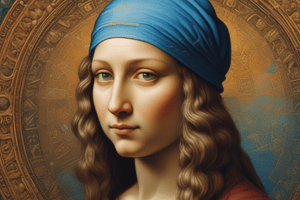Podcast
Questions and Answers
Who is known for their contributions to accounting and bookkeeping?
Who is known for their contributions to accounting and bookkeeping?
- Albrecht Dürer
- Girolamo Cardano
- Niccolò Fontana Tartaglia
- Luca Pacioli (correct)
Who discovered a method for solving cubic equations that was later published by Girolamo Cardano?
Who discovered a method for solving cubic equations that was later published by Girolamo Cardano?
- Luca Pacioli
- Scipione del Ferro (correct)
- John Napier
- Albrecht Dürer
Who invented logarithms?
Who invented logarithms?
- John Napier (correct)
- Albrecht Dürer
- Niccolò Fontana Tartaglia
- Luca Pacioli
Which Italian mathematician is known for his contributions to accounting and bookkeeping?
Which Italian mathematician is known for his contributions to accounting and bookkeeping?
Who discovered a method for solving quartic equations, which were equations of the fourth degree?
Who discovered a method for solving quartic equations, which were equations of the fourth degree?
What Scottish mathematician invented logarithms?
What Scottish mathematician invented logarithms?
Flashcards are hidden until you start studying
Study Notes
Key Developments and Figures in Renaissance Mathematics
- Renaissance mathematics refers to the period of mathematical development that occurred from the 14th to the 17th century in Europe.
- The era marked a significant shift in the development of mathematics as a field of study, laying the foundation for many of the mathematical concepts and techniques that are still used today.
- The discoveries made during this period helped to advance many areas of science and technology, and they continue to have an impact on modern mathematics and its applications.
- Albrecht Dürer, a German painter, printmaker, and theorist, created new methods for perspective drawing and developed a theory of proportions in art, publishing "Underweysung der Messung mit dem Zirckel und Richtscheyt."
- Luca Pacioli, an Italian mathematician and Franciscan friar, is known for his contributions to accounting and bookkeeping, including the detailed explanation of double-entry bookkeeping in "Summa de Arithmetica, Geometria, Proportion et Proportionalità."
- Niccolò Fontana Tartaglia and Girolamo Cardano, Italian mathematicians, made significant contributions to algebra, with Tartaglia being known for his work on solving cubic equations and Cardano credited with the discovery of complex numbers and the solution of the quartic equation.
- Scipione del Ferro, another Italian mathematician, discovered a method for solving cubic equations that was later published by Cardano.
- Gerolamo Cardano was one of the first mathematicians to work with complex numbers and published "Ars Magna," containing many important discoveries in algebra.
- Ludovico Ferrari, a student of Cardano, discovered a method for solving quartic equations, which were equations of the fourth degree, published in "Ars Magna."
- John Napier, a Scottish mathematician, invented logarithms, which are mathematical functions widely used in a variety of fields, including mathematics, physics, engineering, and economics.
- Logarithms are useful for simplifying complex mathematical calculations, particularly in situations where multiplication or division of very large or very small numbers is required.
- The most commonly used logarithm is the base 10 logarithm, which is written as "log" without any subscript, while the natural logarithm has a base of the mathematical constant "e" and is written as "ln."
Key Developments and Figures in Renaissance Mathematics
- Renaissance mathematics refers to the period of mathematical development that occurred from the 14th to the 17th century in Europe.
- The era marked a significant shift in the development of mathematics as a field of study, laying the foundation for many of the mathematical concepts and techniques that are still used today.
- The discoveries made during this period helped to advance many areas of science and technology, and they continue to have an impact on modern mathematics and its applications.
- Albrecht Dürer, a German painter, printmaker, and theorist, created new methods for perspective drawing and developed a theory of proportions in art, publishing "Underweysung der Messung mit dem Zirckel und Richtscheyt."
- Luca Pacioli, an Italian mathematician and Franciscan friar, is known for his contributions to accounting and bookkeeping, including the detailed explanation of double-entry bookkeeping in "Summa de Arithmetica, Geometria, Proportion et Proportionalità."
- Niccolò Fontana Tartaglia and Girolamo Cardano, Italian mathematicians, made significant contributions to algebra, with Tartaglia being known for his work on solving cubic equations and Cardano credited with the discovery of complex numbers and the solution of the quartic equation.
- Scipione del Ferro, another Italian mathematician, discovered a method for solving cubic equations that was later published by Cardano.
- Gerolamo Cardano was one of the first mathematicians to work with complex numbers and published "Ars Magna," containing many important discoveries in algebra.
- Ludovico Ferrari, a student of Cardano, discovered a method for solving quartic equations, which were equations of the fourth degree, published in "Ars Magna."
- John Napier, a Scottish mathematician, invented logarithms, which are mathematical functions widely used in a variety of fields, including mathematics, physics, engineering, and economics.
- Logarithms are useful for simplifying complex mathematical calculations, particularly in situations where multiplication or division of very large or very small numbers is required.
- The most commonly used logarithm is the base 10 logarithm, which is written as "log" without any subscript, while the natural logarithm has a base of the mathematical constant "e" and is written as "ln."
Studying That Suits You
Use AI to generate personalized quizzes and flashcards to suit your learning preferences.




